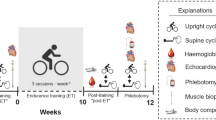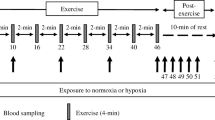Summary
In order to determine the effect of shortterm training on central adaptations, gas exchange and cardiac function were measured during a prolonged submaximal exercise challenge prior to and following 10–12 consecutive days of exercise. In addition, vascular volumes and selected haematological properties were also examined. The subjects, healthy males between the ages of 19 and 30 years of age, cycled for 2 h per day at approximately 59% of pre-training peak oxygen consumption (VO2) i.e., maximal oxygen consumption (VO2 max). Following the training,VO2 max (1·min−1) increased (P<0.05) by 4.3% (3.94, 0.11 vs 4.11, 0.11; mean, SE) whereas maximal exercise ventilation (V E,max) and maximal heart rate (ϕc,max) were unchanged. During submaximal exercise,VO2 was unaltered by the training whereas carbon dioxide production (V E) and respiratory exchange ratio were all reduced (P<0.05). The altered activity pattern failed to elicit adaptations in either submaximal exercise cardiac output or arteriovenous O2 difference. ϕc was reduced (P<0.05). Plasma volume (PV) as measured by125I human serum albumin increased by 365 ml or 11.8%, while red cell volume (RCV) as measured by51chromium-labelled red blood cells (RBC) was unaltered. The increase in PV was accompanied by reductions (P<0.05) in haematocrit, haemoglobin concentration (g. 100 ml−1), and RBCs (106 mm−3). Collectively these changes suggest only minimal adaptations in maximal oxygen transport during the early period of prolonged exercise training. However, as evidenced by the changes during submaximal exercise, both the ventilatory and the cardiodynamic response were altered. Since RCV did not change, it is suggested that the elevated PV accompanying training is instrumental in eliciting the change in cardiac function.
Similar content being viewed by others
References
Anderson P, Henriksson J (1977) Capillary supply of the quadriceps femoris muscle of man. Adaptive response to exercise. J Physiol (Lond) 270:677–690
Clausen JP (1977) Effect of physical training on cardiovascular adjustments to exercise in man. Physiol Rev 57:779–815
Collier CR (1956) Determination of mixed venous CO2 tensions by rebreathing. J Appl Physiol 9:25–29
Convertino VA (1983) Heart rate and sweat rate responses associated with exercise-induced hypervolemia. Med Sci Sports Exerc 15:77–82
Convertino VA, Brock PJ, Keil LC, Bernauer EM, Greenleaf JE (1980a) Exercise training-induced hypervolemia: role of plasma albumin, renin and vasopressin. J Appl Physiol Respir Environ Exerc Physiol 48:665–669
Convertino VA, Greenleaf JE, Bernhauer EM (1980b) Role of thermal and exercise factors in the mechanism of hypervolemia. J App] Physiol 48:657–664
Coyle EF, Hemmert MK, Coggan AR (1986) Effects of detraining on cardiovascular responses to exercise: role of blood volume. J Appl Physiol 60:95–99
Eichner ER (1985) Macrocytosis: a clue to footstrike hemolysis. Am J Med 78:321–325
Fortney SM, Vroman HB (1985) Exercise, performance and temperature control. Temperature regulation during exercise and implications for sport performance and training. Sports Med 2:8–20
Green HJ, Thomson JA, Ball ME, Hughson RL, Houston ME, Sharratt MT (1984) Alterations in blood volume following short term supramaximal exercise. J Appl Physiol Respir Environ Exerc Physiol 56:145–149
Green HJ, Jones LL, Hughson RL, Painter DC, Farrance BW (1987a) Training-induced hypervolemia: lack of an effect on oxygen utilization during exercise. Med Sci Sports Exerc 19:202–206
Green HJ, Hughson RL, Thomson JA, Sharratt MT (1987b) Supramaximal exercise after training-induced hypervolemia. I. Gas exchange and acid-base balance. J Appl Physiol 62:1944–1953
Green HJ, Jones LL, Houston ME, Ball-Burnett ME, Farrance BW (1989) Muscle energetics during prolonged cycling after exercise hypervolemia. J Appl Physiol 66:622–631
Green HJ, Jones LL, Painter DC (1990a) Effects of short-term training on cardiac function during prolonged exercise. Med Sci Sports Exerc 22:488–493
Green HJ, Jones S, Ball-Burnett ME, Fraser IG (1990b) Early muscular and metabolic adaptations to prolonged exercise training in man. J Appl Physiol (in press)
Henriksson J (1977) Training induced adaptation of skeletal muscle and metabolism during submaximal exercise. J Appl Physiol 270:661–675
Hickson RC, Bonze HA, Holloszy JO (1977) Linear increase in aerobic power induced by a strenuous program of endurance exercise. J Appl Physiol Respir Environ Exerc Physiol 42:372–376
Holloszy JO, Coyle EF (1984) Adaptations of skeletal muscle to endurance exercise and their metabolic consequences. J Appl Physiol 56:831–838
Holmgren A, Mossfeldt F, Sjostrand T, Strom G (1960) Effects of training on work capacity, total hemoglobin, blood volume, heart volume and pulse rate in recumbent and upright positions. Acta Physiol Scand 50:72–83
Hopper MK, Coggan AR, Coyle EF (1988) Exercise stroke volume relative to plasma volume expansion. J Appl Physiol 61:404–408
Hughson RL, Kowalchuk JM, Prime WM, Green HJ (1980) Opencircuit gas exchange analysis in the non-steady-state. Can J Appl Sport Sci 5:15–18
Hurley BF, Nemeth PM, Martin WH III, Hagberg JM, Dalsky GP (1986) Muscle triglyceride utilization exercise: effect of training. J Appl Physiol 60:562–567
Jones NL, Campbell EJH, Edwards RHT, Robertson DG (1975) Clinical exercise testing. Saunders, Toronto
Jones NL, Robertson DG, Kone JW (1979) Differences between end-tidal and arterialPCO2 in exercise. J Appl Physiol 47:954–960
Kanstrup I, Ekblom B (1982) Acute hypervolemia, cardiac performance and aerobic power during exercise. J Appl Physiol Respir Environ Exerc Physiol 52:1186–1191
Karlsson J, Nordesjo L-O, Jorfeldt L, Saltin B (1972) Muscle lactate, ATP and CP levels during exercise after physical training in man. J Appl Physiol 33:199–203
Koyal SN, Whipp BJ, Huntsman D, Bray GA, Wasserman K (1976) Ventilatory responses to the metabolic acidosis of treadmill and cycle ergometry. J Appl Physiol 40:864–867
Magnussen B, Hallberg L, Rosslander L, Swolin B (1984) Iron metabolism and “sports anemia”. II. A hematological comparison of elite runners and control subjects. Acta Med Scand 216:157–164
Mairbäurl H, Humpeler E, Schwaberger G, Pessenhofer H (1983) Training-dependent changes of red cell density and erythrocytic oxygen transport. J Appl Physiol 55:1403–1407
Najean Y, Cacchione R (1977) Blood volume in health and disease. Clin Haematol 6:543
Radomski MW, Sabiston BH, Isoard P (1980) Development of “sports anemia” in physically fit men after daily sustained submaximal exercise. Aviat Space Environ Med 51:41–45
Remes V (1979) Effect of long-term physical training on red cell volume. Scand J Clin Lab Invest 39:311–319
Rowell LB (1986) Circulatory adjustments to dynamic exercise and heat stress: competing controls. In: Rowell LB (ed) Human circulation regulation during physical stress. Oxford University Press, New York, pp 363–406
Saltin B, Rowell LB (1980) Functional adaptations to physical activity and inactivity. Fed Proc 39:1506–1513
Senay LC, Mitchell D, Wyndham CH (1976) Acclimatization in a hot, humid environment: body fluid adjustments. J Appl Physiol 40:786–796
Shiraki K, Yamada T, Yoshimura H (1977) Relation of proton nutrition to the reduction of red blood cells induced by physical training. Jpn J Physiol 27:413–421
Winder WW, Hagberg JM, Ehsani RC, McLane JA (1978) Time course of sympathoadrenal adaptation to endurance training in man. J Appl Physiol Respir Environ Exerc Physiol 45:370–374
Winder WW, Hickson RC, Hagberg JM, Ehsani AA, McLane JA (1979) Training-induced changes in hormonal and metabolic responses to submaximal exercise. J Appl Physiol Respir Environ Exerc Physiol 46 (4):766–771
Wyndham GH, Rogers GG, Senay LC, Mitchell D (1976) Acclimatization in a hot humid environment: cardiovascular adjustments. J Appl Physiol 40:779–785
Author information
Authors and Affiliations
Rights and permissions
About this article
Cite this article
Green, H.J., Coates, G., Sutton, J.R. et al. Early adaptations in gas exchange, cardiac function and haematology to prolonged exercise training in man. Europ. J. Appl. Physiol. 63, 17–23 (1991). https://doi.org/10.1007/BF00760795
Accepted:
Issue Date:
DOI: https://doi.org/10.1007/BF00760795




